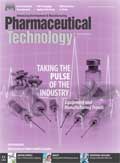Getting Comfortable With Lean
Contract research, development, and manufacturing organizations (CROs, CDMOs and CMOs) are embracing lean manufacturing, while Big Pharma is applying it, not so much for inventory management, but to improve supply chain visibility and control.
Monty Rakusen/Getty Images

In the past two decades, drug manufacturing companies launched the industry’s first corporate lean manufacturing (Lean) and operational excellence (OpEx) programs. Using modern industrial engineering concepts advanced by thinkers such as Deming, Juran, Shewhart, and principles from the Toyota Production System (TPS), companies began to apply models from other industries to change the way they approached operations and inventory management at key facilities. At Johnson & Johnson, Bristol Myers Squibb, Novartis, and Wyeth, the rise of teams led by empowered operators and a focus on inventory management and metrics such as overall equipment effectiveness (OEE) were seen.
As Japanese terms and phrases such as Kanban, Kaizen, and gemba entered pharma’s lexicon, observers challenged the industry to get better at inventory management, offering Dell Computer and Amazon as role models (1). If Apple can get its inventory turns to 74 (1), and Dell to 36, they reasoned, why should pharma’s continue to hover around 2.3 (2)?
Now, there is little media coverage of Lean pharma programs. Drug companies have reduced headcount between 2009 and 2014, 156,000 jobs were lost in the United States alone, according to the executive recruiter, Challenger Grey Christmas (3). Pharmaceutical manufacturers have also shut down major research and manufacturing facilities.
Mergers have complicated the picture not only recent inversions, but prior consolidations, which have challenged companies to connect different legacy systems and cultures. The Lean and OpEx showcase plants of the past have been closed or sold. Wyeth is now part of Pfizer, and its showcase Lean Pearl River plant is no longer manufacturing. Novartis’ Diovan has come off patent, and its Lean plant in Suffern has been shut down. J&J, the first drug company to launch a formal corporate OpEx program, has faced some serious compliance and quality problems at its facilities.
The Toyota Production System (TPS) introduced many to new terms routinely used in Japan, that are crucial to success in eliminating waste and improving agility.
Kanban-Used in Just in Time or “pull” operations, in which manufacturing is dictated by market demand, are communications tools that show delivery of a given quality.
Kaizen-Small, incremental improvements in some process, typically solicited from people on the plant floor or lab.
Gemba-The place where truth will be found, or where work is done. TPS requires top managers to visit the gemba to understand employee and customer needs.
A full glossary can be found at http://us.kaizen.com/know.
Does this mean that pharma has suspended its efforts in Lean and OpEx? Observers see pharma as entering a new, more difficult phase in its Lean evolution, since manufacturing has become so much more complex at pharma facilities. A dedicated pharmaceutical manufacturing plant that might have made one or two products in the past may now be manufacturing 20 or 30 for different global markets.
“The biggest challenge for today’s pharma OpEx programs is that plants have much higher mix now than they did in the past,” says Tom Knight, CEO of Invistics, a Georgia-based company that offers cloud-based software to monitor and improve control of Lean metrics. “Employees are being asked to do more production at the same facility,” he says.
“The easily achievable cost saving projects of the past were completed with much fanfare. Now, the more complex projects will take more effort, resources, buy-in, management commitment, and time,” notes Prabir Basu, consultant and former head of the National Institute for Pharmaceutical Technology and Education (NIPTE).
Adding complexity is the fact that OpEx requires open communications, and pharma still tends to be siloed. “Over the past decade, I’ve come to the conclusion that pharma’s compliance and quality issues are largely due to communications. You need to communicate before you can coordinate, and to coordinate before you can collaborate,” says William Botha, a lean consultant based in California who has held senior positions at large biopharma companies.
“There is often a miscommunication of standards and vision, and lack of feedback to teams on where they are in terms of performance and what is required,” he says. “Lean and OpEx tools, from standard work to kaizen, are all about communication,” he says.
Some see this silence about Lean as a sign that OpEx adopters have made it part of their cultures. After all, after movies like Gung Ho in the 1980s, one never hears about automotive’s Lean projects anymore, notes Greg Anthos, senior managing consultant for life sciences with Tunnell Consulting (King of Prussia, PA). “Early pharma adopters have moved from major upskilling to more of a maintenance of skills and more targeted activities in focused target areas,” Anthos says. “At some companies, Lean and OpEx have become the way they do business, as they have at GE and Ford.”
There are still a lot of OpEx projects going on, notes Lean expert Thomas Friedli, professor at the University of St. Gallen, Switzerland. “Today, generics companies are working to systematize their global approaches to continuous improvement, and contract manufacturers are also following this path,” he says. He also sees much more engagement to OpEx coming from quality departments.
Perhaps today’s Lean goals have become more limited but also, more realistic. Drug shortages, aging facilities, a drier pipeline of new products, and manufacturing problems have made it less important to manage inventories as well as Apple, than to guarantee a stable supply of quality product.
As a result, observers may not be seeing that much improvement in pharma’s inventory turns, but they note a real improvement in metrics such as reduction in cycle time and cost of goods sold (COGS). These efforts are occurring as Big Pharma outsources more functions. In turn, contract companies are developing their own flavors of OpEx and Lean.
CMOs: pharma’s latest converts
Where, in the past, Big Pharma companies would transfer their own OpEx programs to contract partners and suppliers, today, contract research, development and manufacturing organizations (CMOs, CDMOs, and CROs) have their own programs in place. Patheon is an example, but smaller companies such as Rottendorf are also doing this.
Some pharma companies and their contract partners share data to gain one view of their combined supply chain. Shire Pharmaceuticals and its contract partner Patheon, for instance, linked data to build a dashboard that provides visibility at all points along the supply chain, from API plant to finished drug product to packaging and finally, logistics, and distribution. The companies used Invistics’ technology to build this feature, and other pharma-contract duos are building common dashboards to increase transparency. “Often, separate companies have very little visibility into their supply chain. This can lead to firefighting, a lot of excess inventory and wasted effort,” says Knight. The project reduced Shire’s cycle times by 40%.
In another project, Mylan Pharmaceuticals is using a platform developed by Invistics and BuzzeoPDMA, based on Lean and Six Sigma principles, to offer real-time dashboards and insight into controlled substance supply chains and sample activity.
From plant floor to development lab
A growing number of Big Pharma’s current OpEx projects are moving well beyond the plant floor, into areas such as development, from late-stage research to commercialization. “That’s where you can have the greatest impact on the patient on the outcome and the cost structure of the product,” says Anthos. “Adopters are applying Lean and OpEx concepts earlier in process development, not only to get a more robust product, but also a more effective and efficient process from the start,” he notes. This isn’t always easy, he adds, because they’re also trying to speed time to market, and the goals are sometimes in conflict.
A growing number of quality professionals are advocating for OpEx and Lean, notes Botha. This will be important, because the recent past has seen so many compliance failures in the industry. However, there is a need to build quality into the OpEx program, notes Basu, or the company will eventually compromise on quality.
“When I was involved in Six Sigma type operational excellence programs at Pharmacia, quality and regulatory groups were part of the team, and they were integral to the cost savings programs,” he says. Short-sighted managers do not realize that integrated programs not only improve quality but save money. In addition, they often fail to understand that most of the cost of poor quality and noncompliance results from inefficient operations, Basu says. “Cost and effort go into failed batches, incident investigations and deviation explanations,” he says, noting that long-term management commitment is needed for synergistic programs to succeed.
Guilt by association?
The very term “Lean” may have a negative connotation to many who don’t know what it is, Basu notes. Some companies have used the term as a euphemism for downsizing and cutting corners.
Applying Lean and efficiency programs to a dysfunctional system only leads to failure. Anthos suggests that managers ask some deep questions, and fix any problems that they find, before embarking on any efficiency programs. “How robust are your processes? Can you make a product on time and get it to the patient, at the right quality and efficacy? It’s a waste of time to talk about efficiencies when you’re not good at what you’re doing.”
Critics have also complained that Lean and OpEx are being misapplied to drug discovery and R&D, and stifling innovation. Outreach and training are needed to counter these problems, experts agree. The serendipity of inspiration and innovation, those “aha” moments, cannot be subjected to Lean and OpEx analysis, but the processes and labs supporting that innovation and connecting it to other vital operations can, and should, says Anthos.
The key to success in Lean and OpEx remains top-down management support, consultants agree. In today’s business environment, some pharma CEOs are too distracted by major top-line business challenges, such as which companies to acquire, which therapeutic areas to focus on, and how to improve their business models, Anthos says. Thus, the image of the Toyota-style CEO rolling up his or her sleeves and going to visit company labs and manufacturing facilities has not yet taken root in pharma.
Some managers had an awakening as part of consent decrees, which required that they spend more time in the gemba. But Botha sees a change taking place in younger pharma managers.“Younger leaders like to get on the floor more, maybe because they haven’t spent 20-30 years being rewarded for being in meetings,” he says. “They are more social, more savvy about building relationships, and they seem to understand that it’s all about people, and that what got them to their current position won’t guarantee the next promotion.”
To paraphrase Mark Twain, rumors of Lean’s death in pharma have been highly exaggerated. If you don’t hear anything about OpEx at the pharma plant near you, or even your own lab or facility, that doesn’t mean it isn’t happening. Pharma Lean and OpEx programs are alive and well, but moving into new spaces.
References
1. Apple Turns Over Entire Inventory Every Five Days, appleinsider.com, accessed July 23, 2015.
2. R. Spector, How Lean is Pharma? Pharmamanufacturing.com, 2010, accessed July 23, 2015.
3. Pharma Mergers Mean Layoffs, wsj.com, accessed 23 July 2015.
Article DetailsPharmaceutical Technology
Vol. 39, No. 8
Pages: 46–48
Citation: When referring to this article, please cite it as A. Shanley, " Getting Comfortable With Lean," Pharmaceutical Technology 39 (8) 2015.

Drug Solutions Podcast: A Closer Look at mRNA in Oncology and Vaccines
April 30th 2024In this episode fo the Drug Solutions Podcast, etherna’s vice-president of Technology and Innovation, Stefaan De Koker, discusses the merits and challenges of using mRNA as the foundation for therapeutics in oncology as well as for vaccines.